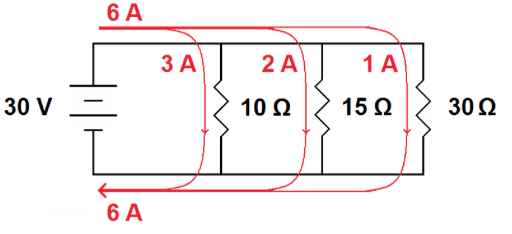9.4 Kirchhoff’s Junction Rule, Ohm’s Law (Resistors in Series and Parallel)
As of 2021, the College Board tests only Units 1-7 on the AP Physics 1 exam. Although this content will not be directly tested, it remains a valuable resource for understanding circuit behavior.
Enduring Understanding 5.C
The electric charge of a system is conserved.
Essential Knowledge 5.C.3
Kirchhoff’s Junction Rule describes the conservation of electric charge in electrical circuits. Since charge is conserved, the current must also be conserved at each junction in the circuit. This applies to circuits that combine resistors in series and parallel.
Note: For AP Physics 1, you may encounter series circuits with one parallel branch.

Kirchhoff’s Junction Rule
Kirchhoff’s Junction Rule uses the principle of charge conservation. In a closed system:
Current Conservation: The total current entering a junction equals the total current leaving the junction.
Charge Conservation: There is no creation or loss of charge within the circuit.
Example:
In a circuit where the total current is 6A, the current splits at a junction into branches based on the resistance of each branch. The branch with higher resistance carries less current, and the currents from all branches recombine as they exit the junction.
Applications:
The rule ensures that the charge is evenly distributed in the circuit.
It works in tandem with Kirchhoff’s Loop Rule to analyze complex circuits.
Combining Kirchhoff’s Laws
Kirchhoff’s Junction Rule and Loop Rule help derive the equivalent resistance for series and parallel circuits.
Series Circuit:
Characteristics: One continuous path.
Current: The same current flows through all components.
Voltage: The sum of voltage drops equals the total voltage supplied by the battery.
Equivalent Resistance:
Key Insight: Adding another resistor in series increases the total resistance of the circuit.
Parallel Circuit:
Characteristics: Two or more paths for current.
Voltage: The voltage across each branch is equal to the total voltage supplied.
Current: The total current is the sum of currents in all branches.
Equivalent Resistance:
Key Insight: Adding another resistor in parallel decreases the total resistance of the circuit.
Practical Implications
Circuit Design:
Adding resistors in series increases resistance and reduces current.
Adding resistors in parallel reduces resistance and increases total current capacity.
Energy Efficiency:
Understanding resistance helps in designing circuits that optimize power usage.
Problem Solving:
Use Kirchhoff’s Rules to solve for unknown values of current, voltage, and resistance in complex circuits.
Key Takeaways
Kirchhoff’s Junction Rule is rooted in charge conservation and is essential for analyzing circuits.
Resistors in series increase total resistance, while resistors in parallel decrease it.
Combining Ohm’s Law and Kirchhoff’s Rules provides a comprehensive method for circuit analysis.







